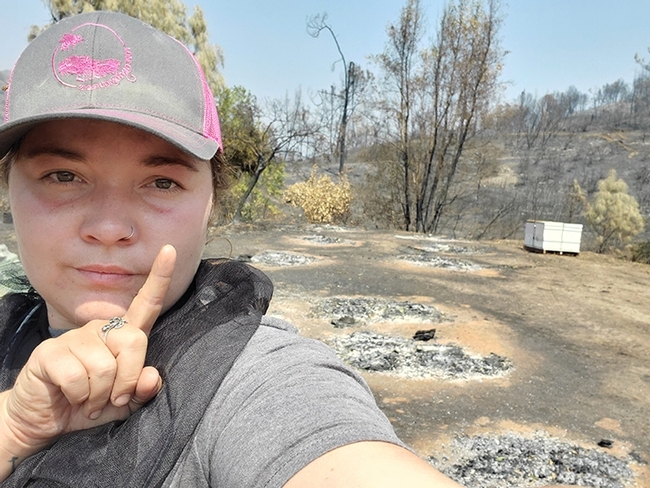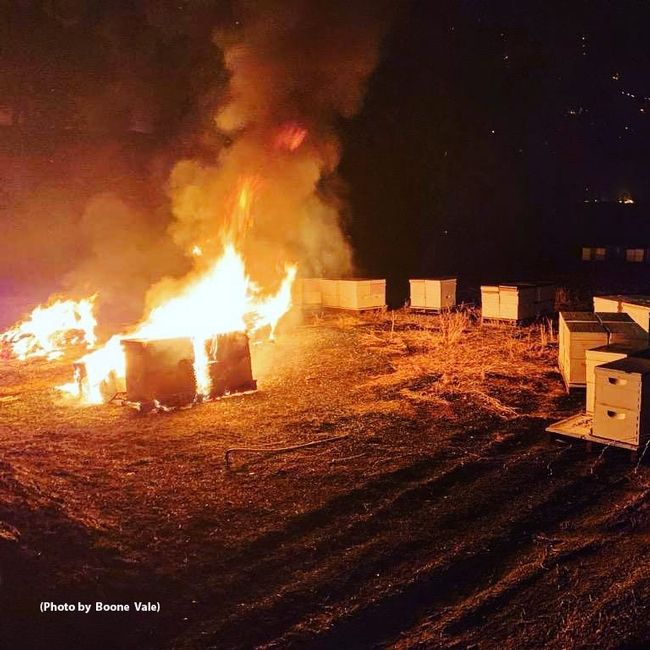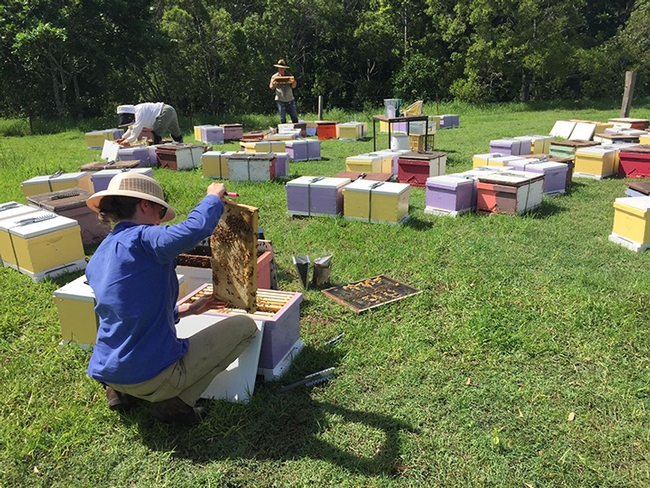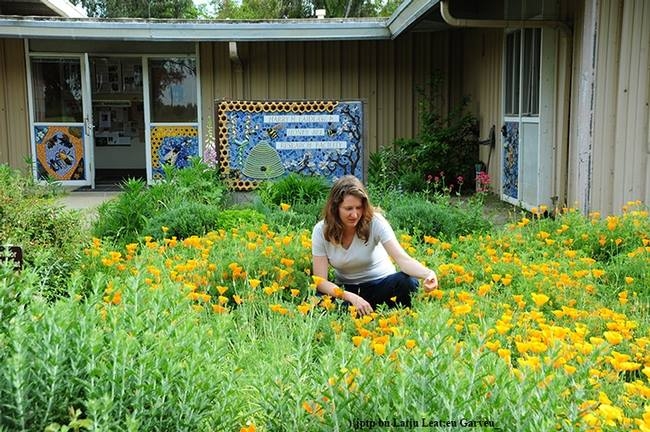
UC Davis alumnus and bee expert Elizabeth Frost, a technical specialist for bees with the New South Wales Department of Primary Industries, sadly knows the fire scene well.
Frost, a 13-year beekeeper, recently authored "24 Million Acres: Reports from Australia's Massive Fire Scar," published in the quarterly magazine, 2 Million Blossoms. The informative piece tackles the subject of Australian bushfires and it provides insight into the kind of scorched path lying ahead for California beekeepers.
"Bees don't abscond but stay with the hives as far as I can tell from beekeeper anecdotal evidence," Frost told us this week. "Where a 'cool' burn runs quickly through the bee yard, hives generally suffer from radiant heat. Post-fire, they should should be fed supplementally if there are no natural food sources where they can be moved to, and requeened. Otherwise, ongoing queen/productivity issues result."
At UC Davis, Frost worked with bee breeder-geneticist Susan Cobey (now at Washington State University) at the Harry H. Laidlaw Jr. Honey Bee Research Facility. The two colleagues are closely following the California wildfire disaster. "This is devastating--it will take years to recover," Cobey said.
An integral part of what's occurring both here and Australia, the colleagues said, is climate change. "Prolonged and potentially extreme bushfire seasons in Australia due to climate change is our present reality, not our future," wrote Frost in 2 Million Blossoms.
Meanwhile, the Australian Honey Bee Industry (see its website, http://www/honeybee.org.au, is rebuilding the bushfire-devastated honey bee and pollination industry.
Frost described the 2019-20 bush fires in 2 Million Blossoms: "24 million acres were burnt in Australia's 2019-2020 bushfire season. In Australia's biggest beekeeping state, New South Wales (NSW), the 2019-20 bush-fires burnt through 13 million acres, 7% of the state's area, including 37% of NSW National Parks and 50% of State forests. NSW Apiarists' Association President Stephen Targett noted, “NSW Bushfires have burnt over 9,809 hives and wiped out the field of over 88,094 hives and burnt just over 5 million hectares of forests. With minimal autumn prospects, a small percentage of these affected hives will be suitable for almond pollination. While the mature almond orchards in Australia don't cover anywhere near as much land as in the United States, they still require around 220,000 hives in August, when mass bloom occurs in the Southern Hemisphere."
"This bushfire disaster was unprecedented in its impact on the Australian beekeeping industry which relies on native tall timber forests of nectar and pollen yielding trees to produce 30,000 tons of honey in a good year," Frost wrote. "Most of these species flower once every 3 to 4 years, unless soil moisture is below average for extended periods in which case some trees may not flower for up to 10 years. Australia's unique flora and dispersed bloom times means beekeepers must pay keen attention to botanical detail in order to effectively migrate to nectar flows that are not annual or even biannual. Australia lost vast swathes of vital natural sources of nutrition, species that provide car- bohydrates, proteins, amino and fatty acids, vitamins, and minerals. The bushfires destroyed prime habitat that functioned as a safe haven far from the threat of pesticides to honey bees and native pollinators alike."
Frost called attention to the Commonwealth Scientific and Industrial Research Organisation (CSIRO), a leading Australian federal government scientific agency, that has been conducting bushfire research for almost 70 years. "Bushfires are a natural part of the Australian landscape, necessary for the regeneration of many endemic plant species that evolved with the harsh climatic conditions of the world's lowest, flattest and (apart from Antarctica) driest continents," Frost pointed out. CSIRO reports that “bushfires are the result of a combination of weather and vegetation (which acts as a fuel for the fire), together with a way for the fire to begin – most commonly due to a lightning strike and sometimes human-influences (mostly accidental such as the use of machinery which produces a spark).”
The impact of climate change has led to longer, more intense fire seasons, Frost related, and an increase in the average number of elevated fire weather days, as measured by the Forest Fire Danger Index (FFDI). Last year saw the highest annual accumulated FFDI on record.
"Climate change doesn't cause fires directly, but has caused an increase in the occurrence of extreme fire weather and in the length of the fire season across large parts of Australia since the 1950s," Frost wrote. "In addition to 2019 being the driest year since records began in 1900, it was Australia's warmest year. In 2019 the annual mean temperature was 1.52 °C above average.”
Frost asked: "In the short term, how will the beekeeping industry evolve to cope with millions of acres of its floral resource burnt and unproductive, providing no bee forage for at least the next few years? Supplemental feeding, previously practiced sparingly in Australia, will have to become the norm for the country if beekeepers hope to bring colonies up to required colony strength as agreed in their almond pollination contracts."
Sadly, it's a long recovery as well for the California beekeepers victimized by the wildfires. (To offer financial support for Caroline Yelle, owner of Pope Canyon Queens, access the Gofundme account.)
Attached Images:

Boone Vale, a volunteer with the Bodega Bay Fire Department, took this heartbreaking image of a fire reaching the Pope Valley hives of Caroline Yelle, owner of Pope Valley Queens. Yelle credits him for saving some of her hives. (Photo by Boone Vale, used with permission)

UC Davis alumnus Elizabeth "Liz" Frost (foreground), employed with the New South Wales Department of Primary Industries, transferring nucs in a holding yard. (Photo courtesy of Liz Frost)

UC Davis alumnus Elizabeth "Liz" Frost worked at the Harry H. Laidlaw Jr. Honey Bee Research Facility, UC Davis. (Photo by Kathy Keatley Garvey)